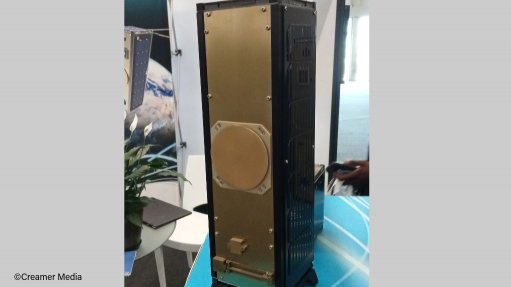
A model of one of the 3U VDES nanosatellites being developed by ASIC
Photo by: Creamer Media's Rebecca Campbell
The Africa Space Innovation Centre (ASIC) of the Cape Peninsula University of Technology (CPUT) is currently busy with its fourth nanosatellite programme, ASIC chief engineer Nyameko Royi tells Engineering News in an exclusive interview. ASIC falls under the CPUT’s Department of Electrical, Electronic and Computer Engineering, in the Faculty of Engineering and the Built Environment.
“This latest mission is to demonstrate a complete VDES,” he explains. (VDES stands for Very high frequency Data Exchange System.) “We’ve developed the VDES in cooperation with our technology partners in industry, S3C. This mission involves two 3U nanosatellites, each of which will have a VDES payload. The VDES will be satellite-to-ground and ground-to-satellite systems.”
Nanosatellites, popularly called CubeSats, although most are now oblongs and not cubes, are categorised by their size. The original CubeSat format is indeed a cube, with dimensions of 10 cm x 10 cm x 10 cm. This is now known as a “one unit” (1U) nanosatellite. A 2U nanosatellite has dimensions of 10 cm x 10 cm x 20 cm, while a 3U example has dimensions of 10 cm x 10 cm x 30 cm (or a little bit longer).
The VDES is for maritime applications, to help monitor South Africa’s exclusive economic zone (EEZ). In 2019, the International Telecommunications Union increased the bandwidth available for use by shipping and shore stations. Previously, ships could only use basic automatic identification systems (AIS), giving their identity and location. But now, they can use VDES and transmit data as well as AIS signals. This will allow better monitoring of compliant shipping operating in the country’s EEZ.
“We expect to complete the flight-ready satellites by April, and hope to launch them during the third quarter, next year,” he reports. The funding for the CPUT’s nanosatellite missions has mainly come from the Department of Science and Innovation (DSI), but also from the South African National Space Agency, with this fourth mission being managed by the Technology Innovation Agency (an entity of the Department of Science and Innovation).
CPUT’s first CubeSat mission saw the building of a 1U nanosatellite, launched into space in 2013. The second mission resulted in a 3U nanosatellite being launched in 2018, while the third resulted in the launch of three 2U nanosatellites in January 2022.
CPUT ASIC is exhibiting at the Group on Earth Observations Week and Ministerial Summit 2023. This is being held at the Cape Town International Convention Centre.